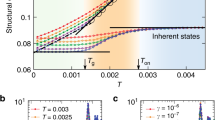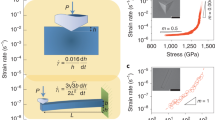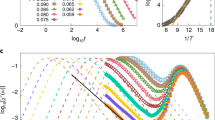Abstract
The viscosity of glass-forming liquids increases by many orders of magnitude if their temperature is lowered by a mere factor of 2–3. Recent studies suggest that this widespread phenomenon is accompanied by spatially heterogeneous dynamics, and a growing dynamic correlation length quantifying the extent of correlated particle motion. Here we use a novel numerical method to detect and quantify spatial correlations that reveal a surprising non-monotonic temperature evolution of spatial dynamical correlations, accompanied by a second length scale that grows monotonically and has a very different nature. Our results directly unveil a dramatic qualitative change in atomic motions near the mode-coupling crossover temperature, which involves no fitting or indirect theoretical interpretation. These findings impose severe new constraints on the theoretical description of the glass transition, and open several research perspectives, in particular for experiments, to confirm and quantify our observations in real materials.
This is a preview of subscription content, access via your institution
Access options
Subscribe to this journal
Receive 12 print issues and online access
$209.00 per year
only $17.42 per issue
Buy this article
- Purchase on Springer Link
- Instant access to full article PDF
Prices may be subject to local taxes which are calculated during checkout



Similar content being viewed by others
References
Adam, G. & Gibbs, J. H. On the temperature dependence of cooperative relaxation properties in glass-forming liquids. J. Chem. Phys. 43, 139–146 (1965).
Debenedetti, P. G. & Stillinger, F. H. Supercooled liquids and the glass transition. Nature 410, 259–267 (2001).
Binder, K. & Kob, W. Glassy materials and disordered solids 2nd edn (World Scientific, 2011).
Ediger, M. D. Spatially heterogeneous dynamics in supercooled liquids. Annu. Rev. Phys. Chem. 51, 99–128 (2000).
Berthier, L., Biroli, G., Bouchaud, J-P., Cipelletti, L. & van Saarloos, W. (eds) Dynamical Heterogeneities in Glasses, Colloids, and Granular Media (Oxford Univ. Press, 2011).
Bennemann, C., Donati, C., Baschnagel, J. & Glotzer, S. C. Growing range of correlated motion in a polymer melt on cooling towards the glass transition. Nature 399, 246–249 (1999).
Berthier, L. et al. Direct experimental evidence of a growing length scale accompanying the glass transition. Science 310, 1797–1800 (2005).
Dalle-Ferrier, C. et al. Spatial correlations in the dynamics of glassforming liquids: Experimental determination of their temperature dependence. Phys. Rev. E 76, 041510 (2007).
Chandler, D. & Garrahan, J. P. Dynamics on the way to forming glass: Bubbles in space-time. Annu. Rev. Phys. Chem. 61, 191–217 (2010).
Kirkpatrick, T. R., Thirumalai, D. & Wolynes, P. G. Scaling concepts for the dynamics of viscous liquids near an ideal glassy state. Phys. Rev. A 40, 1045–1054 (1989).
Xia, X. Y. & Wolynes, P. G. Fragilities of liquids predicted from the random first order transition theory of glasses. Proc. Natl Acad. Sci. USA 97, 2990–2994 (2000).
Franz, S. & Montanari, A. Analytic determination of dynamical and mosaic length scales in a Kac glass model. J. Phys. A 40, F251–F257 (2007).
Kirkpatrick, T. R. & Thirumalai, D. Dynamics of the structural glass transition and the p-spin interaction spin glass model. Phys. Rev. Lett. 58, 2091–2094 (1987).
Götze, W. Complex Dynamics of Glass-Forming Liquids: A Mode-Coupling Theory (Oxford Univ. Press, 2008).
Biroli, G. & Bouchaud, J. P. Diverging length scale and upper critical dimension in the mode-coupling theory of the glass transition. Europhys. Lett. 67, 21–27 (2004).
Biroli, G. & Bouchaud, J-P. in The Random First-Order Transition Theory of Glasses: A Critical Assessment (eds Lubchenko, V. & Wolynes, P. W.) (in the press); preprint at http://arxiv.org/abs/0912.2542.
Coslovich, D. & Pastore, G. Understanding fragility in supercooled Lennard-Jones mixtures. I. Locally preferred structures. J. Chem. Phys. 127, 124504 (2007).
Tanaka, H., Kawasaki, T., Shintani, H. & Watanabe, K. Critical-like behavior of glass-forming liquids. Nature Mater. 9, 324–331 (2010).
Montanari, A. & Semerjian, G. Rigorous inequalities between length and time scales in glassy systems. J. Stat. Phys. 125, 23–54 (2006).
Bouchaud, J-P. & Biroli, G. On the Adam–Gibbs–Kirkpatrick–Thirumalai–Wolynes scenario for the viscosity increase in glasses. J. Chem. Phys. 121, 7347–7354 (2004).
Biroli, G., Bouchaud, J-P., Cavagna, A., Grigera, T. S. & Verrocchio, P. Thermodynamic signature of growing amorphous order in glass-forming liquids. Nature Phys. 4, 771–775 (2008).
Scheidler, P., Kob, W. & Binder, K. Cooperative motion and growing length scales in supercooled confined liquids. Europhys. Lett. 59, 701–707 (2002).
Watanabe, K., Kawasaki, T. & Tanaka, H. Structural origin of enhanced slow dynamics near a wall in glass-forming systems. Nature Mater. 10, 512–520 (2011).
Berthier, L. & Witten, T. A. Compressing nearly hard sphere fluids increases glass fragility. Europhys. Lett. 86, 10001 (2009).
Parisi, G. On the replica scenario for the glass transition. Preprint at http://arxiv.org/abs/0911.2265.
Stevenson, J. D., Schmalian, J. & Wolynes, P. G. The shapes of cooperatively rearranging regions in glass-forming liquids. Nature Phys. 2, 268–274 (2006).
Acknowledgements
We thank G. Biroli and A. Cavagna for fruitful exchanges about this work. We acknowlege the financial support from the Région Languedoc-Roussillon (L.B.), ANR DYNHET (L.B. and W.K.), and MICINN (Project: MAT2009-13155-C04-02) and Junta de Andalucía (Project: P07-FQM-02496) (S.R-V.). W.K. is a member of the Institut universitaire de France.
Author information
Authors and Affiliations
Contributions
L.B., W.K. and S.R-V. contributed to the computer simulations, the analysis of the data, and the writing of the paper.
Corresponding author
Ethics declarations
Competing interests
The authors declare no competing financial interests.
Supplementary information
Supplementary Information
Supplementary Information (PDF 2458 kb)
Rights and permissions
About this article
Cite this article
Kob, W., Roldán-Vargas, S. & Berthier, L. Non-monotonic temperature evolution of dynamic correlations in glass-forming liquids. Nature Phys 8, 164–167 (2012). https://doi.org/10.1038/nphys2133
Received:
Accepted:
Published:
Issue Date:
DOI: https://doi.org/10.1038/nphys2133
This article is cited by
-
Modern computational studies of the glass transition
Nature Reviews Physics (2023)
-
Signature of collective elastic glass physics in surface-induced long-range tails in dynamical gradients
Nature Physics (2023)
-
Surface melting of a colloidal glass
Nature Communications (2022)
-
Q-dependent collective relaxation dynamics of glass-forming liquid Ca0.4K0.6(NO3)1.4 investigated by wide-angle neutron spin-echo
Nature Communications (2022)
-
Experimental evidence of mosaic structure in strongly supercooled molecular liquids
Nature Communications (2021)



